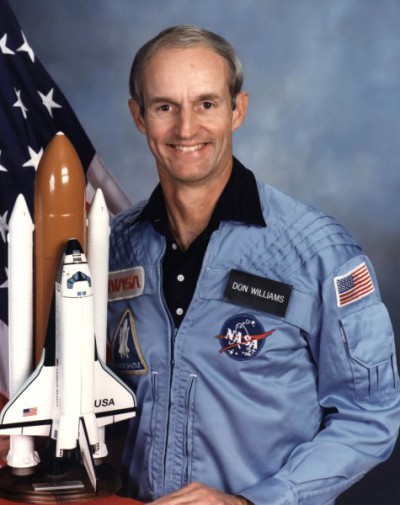Donald Williams (Donald Edward Williams)

Selected by NASA in January 1978, Donald Williams became an astronaut in August 1979, qualified for assignment as a pilot on future Space Shuttle flight crews. Since then he has had various support assignments, including working at the Shuttle Avionics Integration Laboratory (SAIL) as a test pilot, and at the Kennedy Space Center participating in Orbiter test, checkout, launch and landing operations. From September 1982 through July 1983, he was assigned as the Deputy Manager, Operations Integration, National Space Transportation System Program Office at the Johnson Space Center. From July 1985 through August 1986, Williams was the Deputy Chief of the Aircraft Operations Division at the Johnson Space Center, and from September 1986 through December 1988, he served as Chief of the Mission Support Branch within the Astronaut Office. Donald Williams served as pilot on STS-51-D in 1985, and was the spacecraft commander on STS-34 in 1989. STS-51-D Discovery (April 12–19, 1985) was launched from and returned to land at the Kennedy Space Center, Florida. During the mission, the crew deployed ANIK-C for Telesat Canada, and Syncom IV-3 for the U.S. Navy. A malfunction in the Syncom spacecraft resulted in the first unscheduled EVA, rendezvous and proximity operations for the Space Shuttle in an attempt to activate the satellite. Additionally, the crew also conducted several medical experiments, two student experiments, activated two Getaway Specials, and filmed experiments with toys in space. The mission was accomplished in 109 orbits of the Earth in 167 hours, 54 minutes.
STS-34 Atlantis (October 18–23, 1989) was launched from Kennedy Space Center, Florida and returned to land at Edwards Air Force Base, California. During the mission the crew successfully deployed the Galileo spacecraft, starting its journey to explore Jupiter, operated the Shuttle Solar Backscatter Ultraviolet Instrument (SSBUV) to map atmospheric ozone, and performed numerous secondary experiments involving radiation measurements, polymer morphology, lightning research, microgravity effects on plants, and a student experiment on ice crystal growth in space. The mission was accomplished in 79 orbits of the Earth in 119 hours, 41 minutes. In March 1990, Donald Williams retired from the U.S. Navy as Captain, and left NASA. He joined Science Applications International Corporation (SAIC), working on several projects in the Houston area, nationally, and internationally. In April 2006, Williams retired from SAIC. Donald Williams died on February 23, 2016 at the age of 74.
Born
- February, 13, 1942
- USA
- Lafayette, Indiana
Died
- February, 23, 2016



